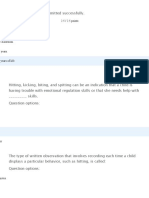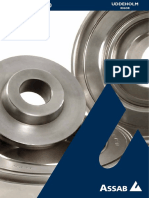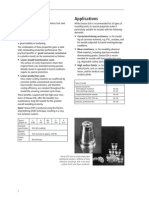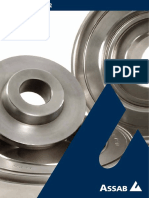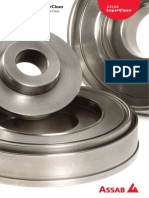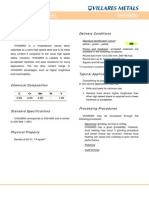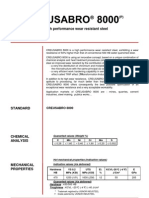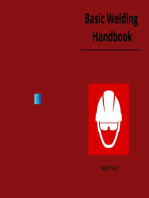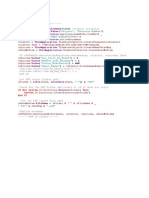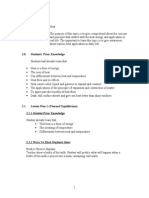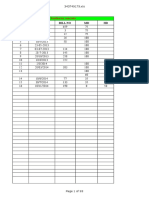Aisi D2: Cold Work Tool Steel
Aisi D2: Cold Work Tool Steel
Uploaded by
Edilson Sarmiento AlonsoCopyright:
Available Formats
Aisi D2: Cold Work Tool Steel
Aisi D2: Cold Work Tool Steel
Uploaded by
Edilson Sarmiento AlonsoOriginal Title
Copyright
Available Formats
Share this document
Did you find this document useful?
Is this content inappropriate?
Copyright:
Available Formats
Aisi D2: Cold Work Tool Steel
Aisi D2: Cold Work Tool Steel
Uploaded by
Edilson Sarmiento AlonsoCopyright:
Available Formats
Great Tooling Starts Here!
TOOL STEEL FACTS
Cold work tool steel
AISI D2
AISI D2
2
This information is based on our present state of knowledge and is
intended to provide general notes on our products and their uses.
It should not therefore be construed as a warranty of specific
properties of the products described or a warranty for fitness for a
particular purpose.
AISI D2
3
Hardened and tempered to 62 HRC. Data at
ambient temperature and elevated temperatures.
Temperature 68F 390F 750F
(20C) (200C) (400C)
Density
lbs/in
3
0.277 0.276 0.275
kg/m
3
7 700 7 650 7 600
Coefficient of thermal
expansion
low temperature
tempering
per F from 68F 6.8 x 10
-6
per C from 20C 12.3 x 10
-6
high temperature
tempering
per F from 68F 6.2 x 10
-6
6.7 x 10
-6
per C from 20C 11.2 x 10
-6
12 x 10
-6
Thermal conductivity
Btu in/ft
2
h F 139 146 159
W/m C 20.0 21.0 23.0
Modulus of elasticity
ksi 30 450 29 000 26 100
MPa 210 000 200 000 180 000
Specific heat
Btu/lbF 0.110
J/kg C 460
Typical
analysis
Standard
specification AISI D2, W.-Nr. 1.2379
Delivery
condition Soft annealed to approx. 210 HB
Color code Yellow/white
General
Forming HRC
Tools for:
Bending, forming, deep-drawing,
rim-rolling, spinning and flow-forming 5662
Coining dies 5660
Cold extrusion dies, 5860
punches 5660
Tube- and section forming rolls; plain rolls 5862
Dies for molding of:
Ceramics, bricks, tiles, grinding wheels,
tablets, abrasive plastics 5862
Thread-rolling dies 5862
Cold-heading tools 5660
Crushing hammers 5660
Swaging tools 5660
Gauges, measuring tools, guide rails,
bushes, sleeves, knurling tools,
sandblast nozzles 5862
Applications
AISI D2 is recommended for tools requiring very
high wear resistance, combined with moderate
toughness (shock-resistance).
AISI D2 can be supplied in various finishes, includ-
ing the hot-rolled, pre-machined and fine
machined condition.
AISI D2 is a high-carbon, high-chromium tool steel
alloyed with molybdenum and vanadium charac-
terized by:
High wear resistance
High compressive strength
Good through-hardening properties
High stability in hardening
Good resistance to tempering-back.
C Si Mn Cr Mo V
1.55 0.3 0.4 11.8 0.8 0.8
COMPRESSIVE STRENGTH
The figures are to be considered as approximate.
Hardness Compressive yield strength, Rc0.2
HRC ksi MPa
62 319 2200
60 312 2150
55 276 1900
50 239 1650
Material
Material Hardness (HB)
Cutting thickness <180 >180
HRC HRC
Tools for:
Blanking, fine-blanking, <1/8" (3 mm) 6062 5860
punching, cropping, 1/81/4"
shearing, trimming, (36 mm) 5860 5456
clipping
Short, cold shears. Shredding knives for
waste plastics. Granulator knives 5660
Circular shears 5860
Clipping, trimming tools Hot 5860
for forgings Cold 5658
Wood milling cutters, reamers, broaches 5860
Properties
PHYSICAL DATA
AISI D2
4
1800 1850 1900 1950 2000F
960 980 1000 1020 1040 1060 1080 C
Austenitizing temperature
STRESS-RELIEVING
After rough machining the tool should be heated
through to 1200F (650C), holding time 2 hours.
Cool slowly to 930F (500C), then freely in air.
HARDENING
Preheating temperature: 11101290F (650750C).
Austenitizing temperature: 18101920F (990
1050C) but usually 18301905F (10001040C).
Temperature Soaking* time Hardness before
F C minutes tempering
1815 990 60 approx. 63 HRC
1850 1010 45 approx. 64 HRC
1885 1030 30 approx. 65 HRC
* Soaking time = time at austenitizing temperature after
the tool is fully heated through.
Protect the part against decarburization and
oxidation during hardening.
SOFT ANNEALING
Protect the steel and heat through to 1560F
(850C). Then cool in the furnace at 20F (10C)
per hour to 1200F (650C), then freely in air.
Heat treatment
QUENCHING MEDIA
Oil (Only very simple geometries)
Vacuum (high speed gas)
Forced air/gas
Martempering bath or fluidized bed at 360
930F (180500C), then cooling in air.
Note: Temper the tool as soon as its temperature
reaches 120160F (5070C).
AISI D2 hardens through in all standard sizes.
TEMPERING
Choose the tempering temperature according to
the hardness required by reference to the temper-
ing graph. Temper twice with intermediate cool-
ing to room temperature. Lowest tempering tem-
perature 360F (180C). Holding time at tempera-
ture minimum 2 hours.
High temperature tempering at greater than 950F
(510C) is recommended if dimensional stability of
tooling is critical, if significant wire EDM opera-
tions are planned in the hardened state, or if tools
are to be coated.
Hardness as a function of austenitizing
temperature
Progressive die made of AISI D2. Long run tooling for
blanking of parts in thin sheets.
Hardness, HRC
70
68
66
64
62
60
58
56
54
52
50
Grain size
Retained austenite
Grain
size
ASTM
10
9
8
7
6
5
4
3
2
1
Hardness HRC
65
60
55
50
45
40
35
30
Retained austenite %
18
14
10
8
1920F
(1050C)
1870F
(1020C)
Retained austenite
1870F (1020C)
Tempering graph
1815F
(990C)
100 200 300 400 500 600 700C
200 400 600 800 1000 1200 F
Tempering temperature
AISI D2
5
Depth of case
Nitriding temperature Nitriding time approx.
F C hours in mm
975 525 20 0.010 0.25
975 525 30 0.012 0.30
975 525 60 0.014 0.35
NITRIDING AND NITROCARBURIZING
Nitriding will give a hard surface layer which is
very resistant to wear and erosion, and also in-
creases corrosion resistance. A temperature of
975F (525C) gives a surface hardness of approx.
1250 HV
1
.
Note: The dimensional changes on hardening and
tempering should be added together.
The minimum recommended machining allow-
ance is 0.15% per side assuming that stress relief
is performed between rough and semifinish ma-
chining, as recommended. If not, machining
allowances must be increased accordingly.
Nitrocarburizing at 1060F (570C) for 2 hours
gives a surface hardness of approx. 950 HV
1
. The
corresponding case depth will be 0.0004"0.0008"
(1020 m).
SUB-ZERO TREATMENT
Pieces requiring maximum dimensional stability
should be sub-zero treated, as volume changes
may occur over the course of time. This applies,
for example, to measuring tools such as gauges
and certain structural components.
Immediately after quenching the piece should be
sub-zero treated to between 95 to 110F (70
and 80C)soaking time 34 hours followed
by tempering. Sub-zero treatment will give a hard-
ness increase of 13 HRC. Avoid intricate shapes
as there will be risk of cracking.
Sub-zero treatment must always be followed by a
series of tempering operations.
Dimensional change %
+0,15
+0,10
+0,05
0
0,05
0,10
200 300 400 500 C
400 600 800 1000F
Tempering temperature
DIMENSIONAL CHANGES
DURING HARDENING
DIMENSIONAL CHANGES
DURING TEMPERING
Heat treatment: Austenitizing temperature 1870F
(1020C), 30 minutes, cooling in vacuum equip-
ment with 2 bar nitrogen overpressure.
Sample, 3.15" x 3.15" x 3.15" (80 x 80 x 80 mm).
Dimensional change, %
+0,10
+0,08
+0,06
+0,04
+0,02
0
0,02
0,04
0,06
0,08
0,10
Length Width Thickness
AISI D2
6
Machining
The cutting data below are to be considered as
guiding values which must be adapted to existing
local conditions.
TURNING
Turning Turning
with carbide with high
Cutting data speed steel
parameters Rough turning Fine turning Fine turning
Cutting
speed (v
c
)
f.p.m. 230360 360500 50
m/min. 70110 110150 15
Feed (f)
i.p.r. 0.0120.023 0.012 0.012
mm/r 0.30.6 0.3 0.3
Depth
of cut (a
p
)
inch 0.080.20 0.08 0.08
mm 26 2 2
Carbide
designation
US C2 C2
ISO K15* K15*
* Use a wear resistant Al
2
O
3
coated carbide grade, for
example Sandvik Coromant GC 4015 or Seco TP100.
MILLING
Face and square shoulder face milling
Milling with Milling
carbide with high
Cutting data speed steel
parameters Rough milling Fine milling Fine milling
Cutting speed
(v
c
) f.p.m. 330400 400460 45
m/min. 100120 120140 14
Feed (f
z
)
in/tooth 0.0080.016 0.0040.008 0.004
mm/tooth 0.20.4 0.10.2 0.1
Depth of cut (a
p
)
inch 0.080.2 0.08 0.08
mm 25 2 2
Carbide
designation US C2 C2
ISO K15* K15*
End milling
Type of milling
Carbide
Cutting data Solid indexable High speed
parameters carbide insert steel
Cutting speed
(v
c
) f.p.m. 80 260430 40
1)
m/min. 25 80130 12
1)
Feed (f
z
)
in/tooth 0.0010.008
2)
0.0030.008
2)
0.0020.014
2)
mm/tooth 0.030.2
2)
0.080.2
2)
0.050.35
2)
Carbide
designation
US C2 C2
ISO K20 K15
3)
* Use a wear resistant Al
2
O
3
coated carbide grade, for
example Sandvik Coromant GC 3015 or Seco T15M.
1)
For coated HSS end mill v
c
56 f.p.m. (17 m/min.)
2)
Depending on radial depth of cut and cutter diameter.
3)
Use a Al
2
O
3
coated carbide grade.
GRINDING
General grinding wheel recommendation for
AISI D2 is given below. More information can be
found in the Uddeholm publication Grinding of
Tool Steel.
Wheel recommendation
Soft annealed Hardened
Type of grinding condition condition
Face grinding A 46 HV B151 R75 B3
1)
straight wheel 3SG 46 HVS
2)
A 46 GV
Face grinding A 24 GV 3SG 36 HVS
2)
segments A 36 G V
Cylindrical A 46 LV B126 R75 B3
1)
grinding 3SG 60 KVS
2)
A 60 IV
Internal grinding A 46 JV B126 R75 B3
1)
3SG 60 JVS
2)
A 60 HV
Profile grinding A 100 LV B126 R100 B6
1)
5SG 80 KVS
2)
A 120 JV
1)
If possible use CBN wheels for this application.
2)
Grinding wheel from Norton Co.
Drill diameter Cutting speed (v
c
) Feed (f)
inch mm f.p.m. m/min i.p.r. mm/r
3/16 5 30* 10* 0.0030.008 0.080.20
3/163/8 510 30* 10* 0.0080.012 0.200.30
3/85/8 1015 30* 10* 0.0120.014 0.300.35
5/83/4 1520 30* 10* 0.0140.016 0.350.40
* For coated HSS drill v
c
~45 f.p.m. (14 m/min.)
DRILLING
High speed steel twist drills
Carbide drills
Type of drill
Cutting data Indexable Solid Brazed
parameters insert carbide carbide
1)
Cutting speed
(v
c
)
f.p.m. 400560 115 145
m/min. 120170 45 35
Feed (f)
i.p.r. 0.0020.010
2)
0.0040.010
2)
0.0060.010
2)
mm/r 0.050.25
2)
0.100.25
2)
0.150.25
2)
1)
Drill with internal cooling channels and brazed carbide
tip.
2)
Depending on drill diameter.
0.080.2
ISO
0.030.2
2)
AISI D2
7
Further information
Contact your local Uddeholm office for further
information on the selection, heat treatment, appli-
cation and availability of Uddeholm tool steels,
including the publications Steels for Cold Work
Tooling.
Electrical-discharge
machining
If EDM is performed in the hardened and tem-
pered condition, the hard brittle white layer must
be completely removed through stoning and
polishing operations and the tool should then be
given an additional temper at approx. 50F (25C)
below the previous tempering temperature.
Further information can be obtained from the
Uddeholm brochure EDM of tool steel.
Welding
Good results when welding tool steel can be
achieved if proper precautions are taken during
welding (elevated working temperature, joint
preparation, choice of consumables and welding
procedure). If the tool is to be polished or photo-
etched, it is necessary to work with an electrode
type of matching composition.
Welding Working Hardness
method temperature Consumables after welding
MMA 390485F Inconel
(SMAW) 200250C 625-type 280 HB
UTP 67S 5558 HRC
TIG 390485F Inconel
200250C 625-type 280 HB
UTPA 73G2 5356 HRC
UTPA 67S 5558 HRC
UTPA 696 6064 HRC
MATERIAL PROPERTIES AND RESISTANCE TO FAILURE MECHANISMS
Relative comparison
of Uddeholm cold work tool steel
Machin-
ability
Grade
Uddeholm
AISI Grindability
Abrasive
wear
Adhesive
wear
AISI O1
AISI A2
AISI D2
COMPAX
SUPREME
VANADIS 4
VANADIS 6
VANADIS 10
Dimension
stability
Fatigue cracking resist.
Ductility/
resistance
chipping
Toughness/
gross
cracking
Hardness/
Plastic
deform.
You might also like
- 2019-07-17T014103.526Document33 pages2019-07-17T014103.526Hammad Tauqeer100% (2)
- Aisi A2: Cold Work Tool SteelDocument21 pagesAisi A2: Cold Work Tool SteelRahul NambiarNo ratings yet
- PB Uddeholm Sverker 21 EnglishDocument12 pagesPB Uddeholm Sverker 21 EnglishulfwisenNo ratings yet
- Assab - XW 10 D20140711Document8 pagesAssab - XW 10 D20140711Orlando CellanNo ratings yet
- D2 Data SheetDocument9 pagesD2 Data SheetJim ToddNo ratings yet
- Bohler - w302 SuperiorDocument8 pagesBohler - w302 SuperiorHugo Mario Ariza Palacio100% (1)
- Assab MaterialDocument8 pagesAssab MaterialFadzlly Abd JalilNo ratings yet
- GB Grade Asp 2060Document2 pagesGB Grade Asp 2060João MirandaNo ratings yet
- Asaab 8407 - 2MDocument11 pagesAsaab 8407 - 2MPrabath MadusankaNo ratings yet
- Assab Stavax EsrDocument6 pagesAssab Stavax EsrAnonymous Wi2Pd2UgPINo ratings yet
- Datasheet Sandvik 12c27 enDocument4 pagesDatasheet Sandvik 12c27 enRizqi D. KurniantoNo ratings yet
- Assab - XW 42 150216Document8 pagesAssab - XW 42 150216Rachmadi NorcahyoNo ratings yet
- 14C28N Draft Data SheetDocument3 pages14C28N Draft Data SheetWarren NelNo ratings yet
- Otel de Scule - GBDocument37 pagesOtel de Scule - GBColta VictorNo ratings yet
- 1.4057 Aisi 431 Data Sheet PDFDocument2 pages1.4057 Aisi 431 Data Sheet PDFGagat GongatNo ratings yet
- A New Die Material For Longer Service LifeDocument12 pagesA New Die Material For Longer Service LifeLuis SantosNo ratings yet
- Yss Tool Steels BDocument77 pagesYss Tool Steels BneramjanNo ratings yet
- Tool Steel Alloy Cr12MoVDocument5 pagesTool Steel Alloy Cr12MoVMujjo Sahb100% (1)
- Dac BDocument15 pagesDac BArief BudimanNo ratings yet
- Specification Sheet: Alloy 310/310S/310H: (UNS S31000, S31008, S31009) W. Nr. 1.4845Document2 pagesSpecification Sheet: Alloy 310/310S/310H: (UNS S31000, S31008, S31009) W. Nr. 1.4845Manoj PaneriNo ratings yet
- ASSAB PM 30 SuperClean Brochure EnglishDocument12 pagesASSAB PM 30 SuperClean Brochure EnglishnithiNo ratings yet
- AISI 1040: Typical AnalysisDocument2 pagesAISI 1040: Typical Analysisho_chauhanNo ratings yet
- PB Uddeholm Sverker 21 EnglishDocument12 pagesPB Uddeholm Sverker 21 EnglishKOSTASPDFNo ratings yet
- Manganese 12 14%Document3 pagesManganese 12 14%Sreedhar Rakesh VellankiNo ratings yet
- Arne English 991008Document7 pagesArne English 991008Mas Ist AsNo ratings yet
- Damasteel Martensitic Damascus SteelDocument6 pagesDamasteel Martensitic Damascus SteelsurintanNo ratings yet
- Material Info - HSS M-42Document4 pagesMaterial Info - HSS M-42ਗਗਨ ਜੋਤNo ratings yet
- LSS A286Document2 pagesLSS A286anhntran4850No ratings yet
- Mitsu End MillDocument20 pagesMitsu End MillTrịnh Văn PhậnNo ratings yet
- Fti Vhssm50 InglesDocument2 pagesFti Vhssm50 InglesAntonio Melgaço da SilvaNo ratings yet
- AISI A2 DatasheetDocument2 pagesAISI A2 DatasheetShivuNo ratings yet
- Standards R M Salem - UserguideDocument49 pagesStandards R M Salem - Userguidearunas1081No ratings yet
- Mirrax 40 EngDocument8 pagesMirrax 40 EngWalter Luis SalvatierraNo ratings yet
- Hardness HSS - SKD11Document5 pagesHardness HSS - SKD11Antonius PrakosaNo ratings yet
- ASSAB PM 23 SuperClean Brochure English PDFDocument12 pagesASSAB PM 23 SuperClean Brochure English PDFnithiNo ratings yet
- PB Alumec EnglishDocument12 pagesPB Alumec EnglishByron RodriguezNo ratings yet
- Dievar D20140715Document16 pagesDievar D20140715Keattikhun ChaichanaNo ratings yet
- 1020 Bright Carbon Steel Bar 2Document3 pages1020 Bright Carbon Steel Bar 2thyskieNo ratings yet
- PB - Uddeholm - Arne - English AISI O1 PDFDocument12 pagesPB - Uddeholm - Arne - English AISI O1 PDFgermanNo ratings yet
- Dillimax 690 eDocument4 pagesDillimax 690 ePrabhakar TiwariNo ratings yet
- Dillimax 690: High Strength Fine Grained Structural Steel Quenched and TemperedDocument4 pagesDillimax 690: High Strength Fine Grained Structural Steel Quenched and TemperedBui Chi Tam100% (1)
- Calmax D20140711 PDFDocument12 pagesCalmax D20140711 PDFSinan YıldızNo ratings yet
- CPM Magnacut - Technical Data: Your in Specialty MetalsDocument2 pagesCPM Magnacut - Technical Data: Your in Specialty MetalscpNo ratings yet
- Sumiten 780SDocument2 pagesSumiten 780Sdiah131No ratings yet
- S 700Document12 pagesS 700HeiderHuertaNo ratings yet
- Corrax D20140714Document8 pagesCorrax D20140714mj_davis04No ratings yet
- Salem Product CatalogueDocument6 pagesSalem Product Cataloguedramilt0% (1)
- ABRAuk Creusabro 4800Document3 pagesABRAuk Creusabro 4800Anonymous 48jYxR1CNo ratings yet
- CRDocument8 pagesCRErfan EffendyNo ratings yet
- Alloy309 SpecSheetDocument2 pagesAlloy309 SpecSheetBilelNo ratings yet
- SS 1.4122Document2 pagesSS 1.4122Bipin Sadasivan100% (2)
- Din 1-3207Document3 pagesDin 1-3207Ornella MancinelliNo ratings yet
- Supply Range of AISI M42 Tool Steel High SpeedDocument4 pagesSupply Range of AISI M42 Tool Steel High SpeedSama UmateNo ratings yet
- PB Uddeholm Calmax EnglishDocument12 pagesPB Uddeholm Calmax EnglishxulubNo ratings yet
- En 10088-3Document2 pagesEn 10088-3H_DEBIANENo ratings yet
- D2 Tool Steel SpecificationDocument1 pageD2 Tool Steel SpecificationRamdika Nur HariantoNo ratings yet
- Thyssenkrupp Materials International: Material Data SheetDocument4 pagesThyssenkrupp Materials International: Material Data SheetjaseerkannothNo ratings yet
- Carpenter Stainless Custom 630 PDFDocument9 pagesCarpenter Stainless Custom 630 PDFGrafton MontgomeryNo ratings yet
- Finite Element Modeling and Analysis: CE 595: Course Part 2 Amit H. VarmaDocument101 pagesFinite Element Modeling and Analysis: CE 595: Course Part 2 Amit H. VarmaEdilson Sarmiento AlonsoNo ratings yet
- Review For Exam 3Document3 pagesReview For Exam 3Edilson Sarmiento AlonsoNo ratings yet
- Export To PDF2Document1 pageExport To PDF2Edilson Sarmiento AlonsoNo ratings yet
- Compressive Properties-ASTM D695Document9 pagesCompressive Properties-ASTM D695Edilson Sarmiento AlonsoNo ratings yet
- D3 Wys PDFDocument3 pagesD3 Wys PDFEdilson Sarmiento AlonsoNo ratings yet
- WWII in EuropeDocument7 pagesWWII in EuropeEdilson Sarmiento AlonsoNo ratings yet
- Teaching Unit Topic 1.0 PurposeDocument51 pagesTeaching Unit Topic 1.0 PurposeZul Fahmi Mohamad SapawiNo ratings yet
- Service Manual Trucks: Electrical Schematic Illustration Index VN, VHD Version2, VTDocument84 pagesService Manual Trucks: Electrical Schematic Illustration Index VN, VHD Version2, VTRegistr RegistrNo ratings yet
- English-Book-II-Part-1-Modern-ProseDocument21 pagesEnglish-Book-II-Part-1-Modern-Prosewaqashussainvikki786No ratings yet
- BPL Materials and Expenditure (2) 20.02.15Document93 pagesBPL Materials and Expenditure (2) 20.02.15mohanNo ratings yet
- Printed Circuit Board Manufacturing and Aluminum Based PCBDocument6 pagesPrinted Circuit Board Manufacturing and Aluminum Based PCBjackNo ratings yet
- Medication SafetyDocument31 pagesMedication Safetyhogidi2600No ratings yet
- New Electrostatic Technology For Desalting Crude OilDocument34 pagesNew Electrostatic Technology For Desalting Crude OilchirinoslaaNo ratings yet
- G6U5 WorksheetDocument15 pagesG6U5 WorksheetlukescienceteacherNo ratings yet
- Basic Electrical RequirementsDocument13 pagesBasic Electrical Requirementsmd_rehan_2No ratings yet
- Slope Failure DeterminationDocument7 pagesSlope Failure DeterminationGanjarAsandiPutraPratama100% (1)
- How To Register Your Company or LLPDocument8 pagesHow To Register Your Company or LLPanoop82No ratings yet
- Water Tube Boiler Water Treated Reference StandardDocument6 pagesWater Tube Boiler Water Treated Reference StandardOA AooNo ratings yet
- Mini Dissertation ExampleDocument5 pagesMini Dissertation ExampleBuyALiteratureReviewPaperUK100% (1)
- VICI DBS User Manual HK Plus WithcartridgeDocument25 pagesVICI DBS User Manual HK Plus WithcartridgeCONVIERTE PDF JPG WORDNo ratings yet
- Rate Analysis Report - Concrete Block MachineAMEX (Version 1)Document21 pagesRate Analysis Report - Concrete Block MachineAMEX (Version 1)Jayaraman KamarajNo ratings yet
- Ôn Tâp HKII 18-4Document4 pagesÔn Tâp HKII 18-4Dung LêNo ratings yet
- MPH - Series MP FILTRIDocument7 pagesMPH - Series MP FILTRIMiguel Angel LopezNo ratings yet
- Confer in TaDocument4 pagesConfer in TaAlexandra Veronica LucaNo ratings yet
- AI-Driven Smile DesigningDocument1 pageAI-Driven Smile DesigningNishanth SudharsonNo ratings yet
- Herpes HSV & HZVDocument11 pagesHerpes HSV & HZVLal RuattlingaNo ratings yet
- HSBCDocument8 pagesHSBCsansari24dNo ratings yet
- Urine AnalysisDocument32 pagesUrine AnalysisbnmjgcNo ratings yet
- Saliva & GCFDocument108 pagesSaliva & GCFdrsmriti100% (1)
- Class 12 Biology Unit 1 AssignmentDocument4 pagesClass 12 Biology Unit 1 AssignmentAbhishekdubey198115dec100% (1)
- Globalfire - AD Series Manual PDFDocument2 pagesGlobalfire - AD Series Manual PDFAdrian Oprisan100% (1)
- Chapter 2 - Switching ConceptDocument97 pagesChapter 2 - Switching ConceptAbdullatif AlbattatNo ratings yet
- Writing Task The Strategy of Regional Economic DevelopementDocument4 pagesWriting Task The Strategy of Regional Economic DevelopementyosiNo ratings yet
- This AC Paragraph Is Final and Will Be Included in The Upcoming Change 2 UpdateDocument27 pagesThis AC Paragraph Is Final and Will Be Included in The Upcoming Change 2 Updatelacsmm982No ratings yet
- Final ThesisDocument201 pagesFinal Thesisanon-529776100% (5)
